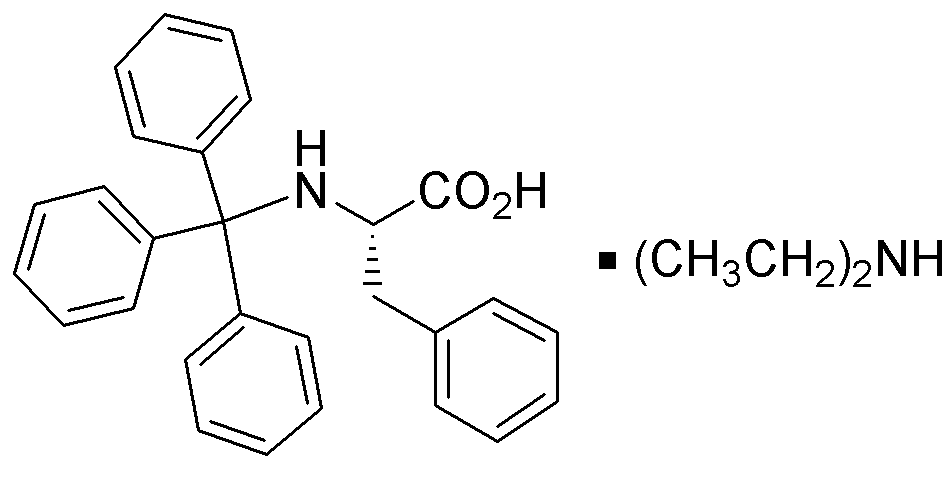Trityl-L-phenylalanine diethylammonium salt is widely utilized in research focused on:
- Peptide Synthesis: This compound serves as a protecting group in the synthesis of peptides, allowing researchers to selectively modify amino acids without interfering with other functional groups.
- Drug Development: It plays a crucial role in the pharmaceutical industry for developing new drugs, particularly in optimizing the pharmacokinetics of peptide-based therapeutics.
- Biotechnology: In biotechnological applications, it is used to enhance the stability and solubility of proteins, which is vital for various bioprocesses and formulations.
- Research in Neuroscience: The compound is utilized in studies related to neurotransmitter pathways, aiding in the understanding of neurological disorders and potential treatments.
- Analytical Chemistry: It is employed as a standard in analytical methods, helping researchers to calibrate instruments and validate results in complex biochemical analyses.
General Information
Properties
Safety and Regulations
Applications
Trityl-L-phenylalanine diethylammonium salt is widely utilized in research focused on:
- Peptide Synthesis: This compound serves as a protecting group in the synthesis of peptides, allowing researchers to selectively modify amino acids without interfering with other functional groups.
- Drug Development: It plays a crucial role in the pharmaceutical industry for developing new drugs, particularly in optimizing the pharmacokinetics of peptide-based therapeutics.
- Biotechnology: In biotechnological applications, it is used to enhance the stability and solubility of proteins, which is vital for various bioprocesses and formulations.
- Research in Neuroscience: The compound is utilized in studies related to neurotransmitter pathways, aiding in the understanding of neurological disorders and potential treatments.
- Analytical Chemistry: It is employed as a standard in analytical methods, helping researchers to calibrate instruments and validate results in complex biochemical analyses.
Documents
Safety Data Sheets (SDS)
The SDS provides comprehensive safety information on handling, storage, and disposal of the product.
Product Specification (PS)
The PS provides a comprehensive breakdown of the product’s properties, including chemical composition, physical state, purity, and storage requirements. It also details acceptable quality ranges and the product's intended applications.
Certificates of Analysis (COA)
Search for Certificates of Analysis (COA) by entering the products Lot Number. Lot and Batch Numbers can be found on a product’s label following the words ‘Lot’ or ‘Batch’.
*Catalog Number
*Lot Number
Certificates Of Origin (COO)
This COO confirms the country where the product was manufactured, and also details the materials and components used in it and whether it is derived from natural, synthetic, or other specific sources. This certificate may be required for customs, trade, and regulatory compliance.
*Catalog Number
*Lot Number
Safety Data Sheets (SDS)
The SDS provides comprehensive safety information on handling, storage, and disposal of the product.
DownloadProduct Specification (PS)
The PS provides a comprehensive breakdown of the product’s properties, including chemical composition, physical state, purity, and storage requirements. It also details acceptable quality ranges and the product's intended applications.
DownloadCertificates of Analysis (COA)
Search for Certificates of Analysis (COA) by entering the products Lot Number. Lot and Batch Numbers can be found on a product’s label following the words ‘Lot’ or ‘Batch’.
*Catalog Number
*Lot Number
Certificates Of Origin (COO)
This COO confirms the country where the product was manufactured, and also details the materials and components used in it and whether it is derived from natural, synthetic, or other specific sources. This certificate may be required for customs, trade, and regulatory compliance.


